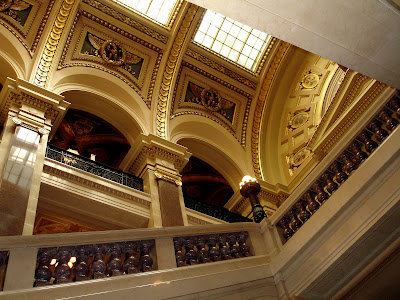All architecture is rooted in philosophy. Philosophy underlies all decisions a designer may make. Put another way: it is nearly impossible to design something without having a point of view. Otherwise, we might as well use a gang of monkeys to randomly construct our buildings.
 |
| 1. Mies Van der Rohe designed the Barcelona Pavilion as an expression of Bauhaus philosophy: rational, simple, industrial, and unadorned. |
We tend to think of architecture as a collection of styles. A menu of choices. It is certainly no such thing, except in the most superficial sense. Nevertheless, the history of architecture is generally told as a story of evolving styles. Styles are a convenient way to categorize the varieties of architectural experience, but behind those styles are philosophies. In other words, behind every style is a set of ideas and a system of values that drive it. That fact is more important than the styles that manifest under various philosophies of architecture.
 |
| 2. Contemporary architect Santiago Calatrava believes architecture is a direct expression of the underlying structure. |
Every major architectural style originates in a particular philosophy of architecture. Each style emerges from the cultural requirements of the society in which it develops and is influenced by the history that preceded it. Architecture does not come about without architects thinking about these sorts of things. Any style is the product of a particular system of thinking about the meaning and purpose of our built environment.
 |
| 3.Architect Bruce Goff believed every building should be designed as if no building ever existed before. |
Perhaps simple, utilitarian buildings can exist without serious thought behind them. However, when a building aspires to be architecture we have to start thinking about the purpose and meaning of the overall space, the outward appearance, and every detail that contributes to the whole. There is no one way to design a building. The choices one makes and the direction one takes are driven by a value system, whether deeply felt or only dimly perceived. Why are certain elements there? What materials should be used? How should we merge size, form, volume, texture and structure? Which are the “right” choices? These are, at root, philosophical questions and are only addressed within a theoretical framework. An architectural philosophy need not be particularly complex. But it must be there in some form or the simplest design decisions become too complex to bear.
 |
| 4. De Architectura by Vitruvius. |
Many books have been written about theories of architecture. The oldest known is De Architectura by the Roman architect Marcus Vitruvius Pollio (1st century B.C.E.) He is still citied today as an authority on architectural principles. Every architecture student learns his famous definition of architecture: a structure which has the qualities of firmitas, utilitas, venustas. That is, it must be strong, functional, and beautiful.
| 5. Saint-Pierre de Rafael. A renaissance plan reflecting the rational values of the time. |
Other books are architectural manifestos written by architects to justify or explain their work. Among the more influential in the modern era are The Timeless Way of Building by Christopher Alexander, S,M,L,XL by Rem Koolhaas, and Learning From Las Vegas by Robert Venturi.
There are also many histories which describe the theoretical goals behind architecture. An excellent example is An Outline of European Architecture by Nikolaus Pevsner.
There are probably as many theories and philosophies of architecture as there are architects. The important thing to remember is that architecture is not mere buildings; it is buildings that reflect ideas.
There are probably as many theories and philosophies of architecture as there are architects. The important thing to remember is that architecture is not mere buildings; it is buildings that reflect ideas.











